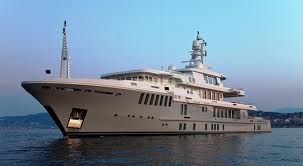We now know that the French Marine Accident Investigation Office, BEAMer (Bureau d’enquêtes sur les évènements de mer) will publish their report into the foundering of the 62 metre super yacht Yogi in ten days time.
Somewhat akin to the British Marine Accidents Investigation Board (MAIB) the report from BEAMer is highly unlikely to lay blame at anyones feet but hopefully will go some way to answering the many questions that the industry has.
The videos of the rescue, posted onto the Internet by the Greek authorities, have been poured over by seaman many of whom have an in depth knowledge of running super yachts of this calibre.
What they have seen and questioned, has raised much debate inside the community in which they work.
Why for example; was Yogidisplaying NUC (Not Under Command) lights as well as steaming lights despite the fact she was clearly sinking?
The carrying of the first suggests the crew fully realised the yacht had problems yet failing to extinguish the latter, is a breach of the Colregs and therefore gives shipping nearby a mixed message.
Where did the life raft, so clearly visible in the rescue videos and seen secured to the vessels port side, come from? Remember the crew have stated earlier that they were unable to launch a life raft and clearly rafts on the port side could not have been released by a hydrostatic release mechanism.
Why, during the incident, was it not possible to use the yachts bow thruster or lower the ships anchors to create a sea anchor effect? Placing the bow of a yacht, without engine power, into the sea would have been the seamanlike thing to do.
Search the Internet and you will find still photographs clearly taken from the helicopters performing the rescue. These are stand-alone shots not grabbed as stills from the video. In several, taken early on in the rescue, there are clear images of cushions normally used on deck, that are seen floating astern of the yacht.
At first thought, this is not unusual, but ask any Captain in command of a super yacht where he would stow deck cushions while on passage in winter, and the answer will undoubtedly be: “below deck” meaning, in all probability, in the Lazerette or beach club.
So here is the question. How is it that cushions, in all probability stowed below decks, are seen to be floating off the yacht’s starboard quarter? Hopefully the French investigators will have quizzed the crew as to how the doors to the beach club came open and allowed the cushions to be blown out, if indeed they were stowed below.
Could it be, that the doors were not dogged down properly before departure? Could that be the reason why water entered into the yacht in the first place? Then perhaps the investigators will ask; how is it, that more than one watertight compartment was flooded on a yacht that should, if good seamanlike practise was followed, have ensured that all water tight doors and hatches were closed while at sea and in heavy weather.
Yet because we know there was water in the yacht, the authorities should ask:
- Why was it allowed to remain there?
- Why were the yacht’s pumps, emergency pumps or even her fire pumps not used to evacuate the water?
It is clear from the video that the generators are working.
Then there are questions to be asked of those vessels who were in the area at the time. These included:
- Grande Sicilia
- Cement Trader,
- Heroi Stakorsky 1
- Eva
Did they offer assistance? Was it refused by those on board Yogi? Did those on board those ships observe how Yogi listed and then sank?
I presume, and indeed hope, that the Greek Coastguard and the French investigators have been talking to each other and shared intelligence, if not compared notes on their respective interviews with the crew of the yacht and the commercial ships that were nearby.
I presume, and indeed hope, that the Greek Coastguard and the French investigators have been talking to each other and shared intelligence, if not compared notes on their respective interviews with the crew of the yacht and the commercial ships that were nearby.
Why was the yacht making way at high speed in such foul weather conditions? Why did she not seek shelter in the lee of the nearby islands?
Under pre departure procedures laid down under the ISM, all the yachts safety and communications equipment would have been checked before setting off to sea.
- Did the ISM procedures work?
- Did this yacht, her owner and DPA have a good understanding and practise of ISM?
Why, when it became clear in the early part of the scenario that all was not well, did the yacht call for a tow towards safety or at the very least into shallow water that was just hours away even at reduced speed?
The primary mission of BEAmer is to conduct technical investigations into marine casualties or incidents. It is also empowered to collect, make use of and disseminate information regarding professional practices and lessons learnt from marine casualties or incidents. I hope that there will be recommendations that will be of value.
I for one, just hope they are true to their mission statement and that with the publication of their report, we learn what caused the well built, well found, Yogi to sink.


Thank for a very interesting article! I think that it is very unlikely that we will get satisfying answers. As far as I heard (and I trust this source) the crew was offered quite an important amount of money for not saying anything. There is another question which could be added to the many interesting points that you made: Why did two Proteskan yachts sink in a very short period of time (Yogi in February 2012 and Vals II in September 2012 off Cap Ferrat), both under mysterious circumstances?